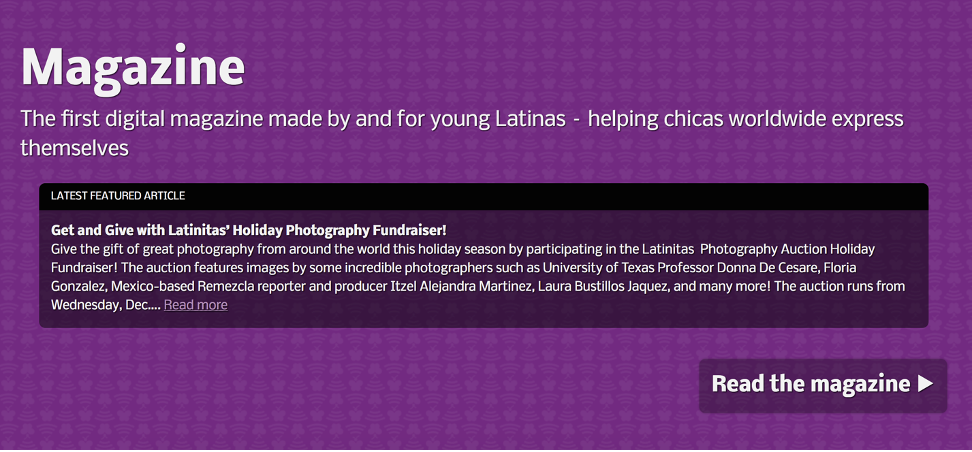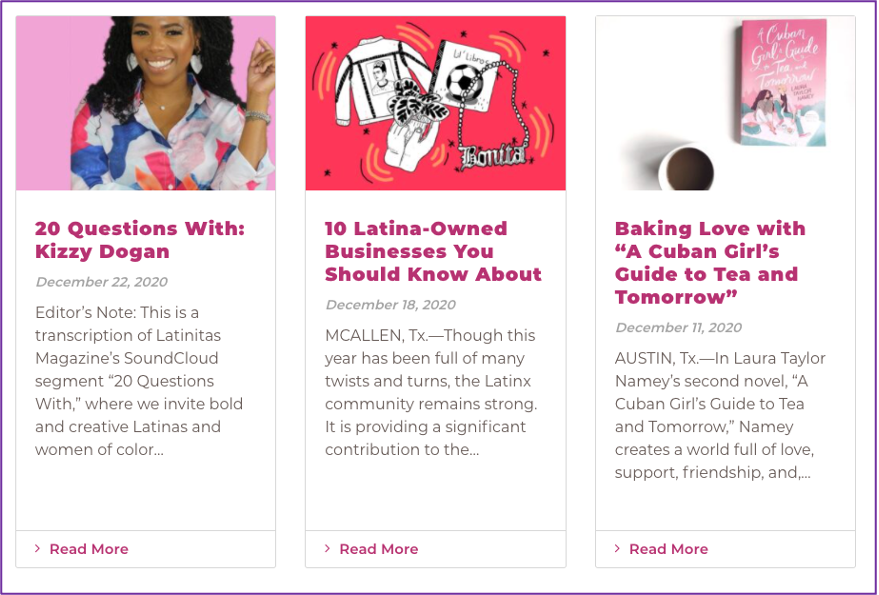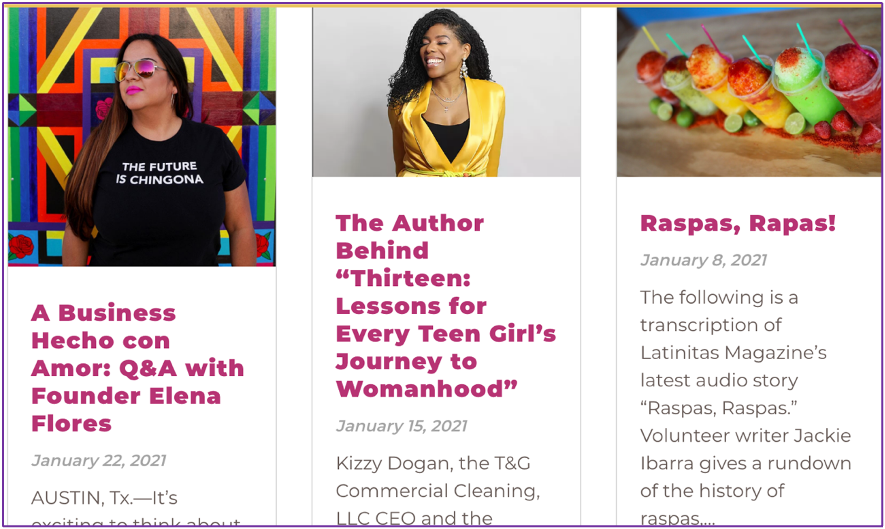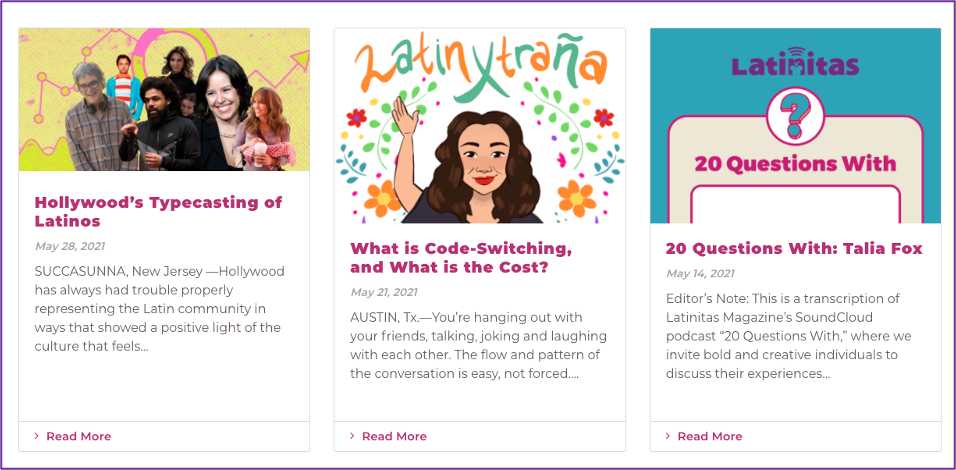Introduction
Located in Austin, TX, Latinitas describes itself as one of the only bilingual tech organizations in the U.S. and prides itself for creating the first digital magazine made for and by Latina youth. In 2002, Latinitas was developed as a project by a group of undergraduate students in a Latinos in Media course at the University of Texas at Austin. Founders of Latinitas saw a need for more representation and stories by Latinas. Prior to the organization receiving its non-profit status, the organization ran as a student-led group. Since 2003, the organization has grown and adapted to the needs of the community and has provided an assortment of writing, leadership, tech, STEM, and college preparation workshops for Latina youth in middle school and high school. Through these workshops and the online magazine, “Latinas discover their voice and develop media skills while building a solid foundation for their future” (Donelly 2017). In addition to serving 3,000 girls annually through a variety of workshops, their online magazine continues to be a key tool for sharing multimedia content that represent the evolving digital landscape and what it means to be a Latina[1]. The work by the magazine’s editors and writers support and circulate the organizational identity[2] of Latinitas. In this article, we focus on how Latinitas, as a Latinx[3] organization, challenges the deficit perspective of Latina youth while trying to keep up with a changing digital landscape.
The Latinx Non-Profit Sector
In 1998, Michael Cortés utilized the term Latino as a collective identity to describe organizations working with the Latino community. Over time, organizations adapted different identity labels (i.e., Hispanic, Latino, etc.) to describe their mission, goals, and values of the organization or the communities they serve. Cortés (1998) defines U.S. based Latino non-profit organizations as:
Organizations whose missions focus on Latino community problems or aspirations; they are controlled or led by Latino community members. In addition, Latino nonprofits are either (a) tax-exempt corporations governed by Latino directors or led by Latino chief executives, or (b) voluntary associations dominated by Latino members or constituents. (19)
An analysis of Latino non-profit organizations in Massachusetts in 2020 led Amplify Latinx and the Mauricio Gastón Institute for Latino Community Development and Public Policy to define a Latino non-profit organization as one that fit all or most of these characteristics:
Its mission and services primarily target Latino communities; Its Executive Director identifies as Latino; Its Board of Directors has a majority of Latino members; Its organizational mission reflects a focus on Latino community needs and on strengthening families, youth, and adult individuals; Its practice promotes cultural proficiency, bilingualism as an asset, and the equitable treatment of Latino in all areas of life; It could be classified as a community-based organization (CBO), i.e., it is organized around a geographic place (i.e., a “community”) in which it provides its services. This distinguishes it from larger non-profits operating at multiple sites as well as from broad based service organizations (e.g., Red Cross).
Both definitions have a clear overlap since they both focus on having a predominantly Latinx mission, leadership, association/representation, and distribution of resources to (or with) Latinx communities. Although Latinx organizations operate within the general non-profit sector, their contributions to collective life have a stronger impact when issues and resources are addressed and given through a Latinx lens. In this article, we use both definitions to frame our approach to defining Latinx nonprofit organizations, the Latinx nonprofit sector, and digital Latinx writing strategies. Using their definitions to describe Latinx non-profit organizations situates the Latinx non-profit sector as a section that has its own nuances, affordances, and exigencies separate from the much larger operations of the non-profit sector. This process allows us to look how the Latinitas Magazine has created a space of multimodal resistance to dismantle white spaces in the non-profit sector. We argue that this is necessary for Latinx organizations to thrive and adapt to social and political climates. Our goal for this paper is not to look at the individual digital Latinx writing practices of the writers, or stand-alone pieces, as other scholars have done. Instead, we will look at how the individual pieces culminate into a collective voice that the organization uses as their digital Latinx writing practice. This exposes the need to disrupt the overwhelming whiteness of the non-profit sector.
Whiteness in the Non-Profit Sector
Each organization’s public writing[4] (i.e., tweets, Facebook posts, content on website, profile pictures and cover photos on social media platforms, etc.) applies cultural rhetorical strategies to create a public image of the organization’s mission, goals, and values. This public image is important to the work the organization does and how they improve the quality of life for Latinx members, but an organization’s public writing also exposes the coded racial language and biases. A clear giveaway is the leadership bios. The non-profit sector, much like academia, is predominantly white (Wallace 2019, Tomkin 2020). In 2006, 82% of executive directors were white, which increased to 87% in 2019 (Derosier 2019). While diversity, inclusion, and equity in non-profit executive leadership continues to be a prominent issue, organizations working with underserved populations (or have a strong BIPOC leadership) are also faced with biased, coded, and discriminatory practices because of the underserved communities they serve. In a series of interviews with 25 BIPOC non-profit practitioners and leaders, a common is thread that BIPOC practitioners are viewed as subordinates and experience a high amount of gaslighting and microaggressions. In the interviews, the “leaders described feeling isolated, navigating difficult, racially fraught power dynamics with grant makers, and enduring affronts to their dignity” (Wallace 2019). The microaggressions they experienced as leaders in the non-profit sector reflects a toxic organizational culture of having to legitimize their credentials and experiences. This type of experience is, unfortunately, common and sustained by whiteness, sexism, and ableism.
Laura Donnelly comments that Latnitas is not immune from struggling with gender and cultural discrimination:
It’s the same cultural and gender issues that you deal with anywhere. Regarding the support and collaboration, you find so much more responsiveness on the side of Latina, you know organizations led that are Latina led as opposed to Latino. You know you have [one that is] kind of doing stuff with us and that I have to beg them to keep pushing the fold. I don’t understand why, but I do think sometimes a male-run organization gets a little ruffled when we start asking them about sort of working together on the same level. They’re patronizing. We’re both 40-something, we’re both Executive Directors, we’re both working in similar ballparks budget ranges, you know, comparable, and they’re still talking to me like I’m their little sister. There’s some problems there.
Latinx organizations are not exempt from being gatekeepers and upholding or benefiting from whiteness. Latinx organizations embed cultural identifiers to establish bonds and reflect the same values and traditions of the population they serve. This process can have both beneficial and biased effects because it can potentially lead to adhering to tropes that can harm the organization or be ostracized by funders (Wallace 2019). Latinx organizations have been criticized for focusing too much on representation and inclusivity (e.g. Latinidad). By relying on Latinidad to change the narrative, Latinx organizations are not doing enough to rectify the colorism and sexism that is embedded in using Latinidad[5]. For Black and Indigenous communities, Latinidad enacts anti-Black violence because Latinidad benefits from whiteness. Black and Indigenous communities are erased since representation by Latinx organizations often focus on abled, white-passing Latinx individuals and communities (both online and in leadership roles). Even though the digital writing practices of Latinx organizations have different needs and exigencies than its white counterparts, they are still susceptible to acting like the same gatekeepers they are fighting against. In 2018, Suarez, Co-President and Editor in Chief of Nonprofit Quarterly, argued that the nonprofit sector is caught in a “narrative loop around racial inequity” due to the lack of accountability from white leadership. Similarly, Tomkin (2020) adds that the nonprofit sector is rooted in white supremacy due to the lack of engagement and action from leaders. According to Tomkin (2020), the discussion of racial inequality, white spaces, and white narratives are an illusion of allyship and are seen as performative actions if leaders do not implement the ideas of BIPOC practitioners, hire more BIPOC leaders, or attempt to fight system inequalities within their own organizational structure. This critique is common amongst BIPOC practitioners since leaders and the nonprofit sector itself are gatekeepers that benefit from upholding whiteness and maintaining white spaces. For Latinitas, the aforementioned “narrative loop around racial inequality” continues to be an ongoing issue that continues to be addressed.
Latinitas
Latinitas prides itself in adapting and growing as an organization and of their ability to reclaim spaces for Latinas. Since 2002, the organization has adapted to the social and political climate of Texas and the nation. Much of the reflexive and transformative work can be identified in their online magazine. The growing tech industry in Austin, Texas led to more partnership opportunities with larger corporations. As a result, Latinitas strives to adapt and serve as a resource for Latina youth. Laura Donnelly, Founder and Chief Operating Officer at Latinitas, notes the importance of adapting to the digital landscape and the need to change the narrative/discourse about Latinos:
You have the big players on a federal level, like Lulac, Unidos, NEHJ, but they’re struggling to connect with a younger audience. They’re struggling to connect with a younger audience and everything that is connected to that. Where they live, communication, and what their complex priorities are located. I feel like when you speak generally about the Hispanic-Latino non-profit sector we are competitive within ourselves, amongst ourselves. That’s frustrating. In the micro-community of Austin and El Paso, I’m seeing it with agencies we should be aligning with better. I’m seeing it with agencies in DC and in New York. I do share a space with 2- 3 nonprofits that are at least 15 years older than us. I see them operating like it is 1960. You can’t exist without concerns of rent or the impact of gentrification or the needs to stay current with technology. So, I see them not keeping up. I see them not even wanting to keep up, and, yet they grow really frustrated or challenged when they are not seen as a competitive service organization in the community.
To adapt to the digital landscape and stay current, Latinitas launched an online magazine in 2003. The purpose of the magazine is to curate culturally sensitive content by Latina youth for Latina youth. The name of the organization itself, Latinitas (Latina with the diminutive –ita to demonstrate affection), represents the organization’s origin story of needing to fill the large gap of Latina representation in media. For the organization, media and technology keeps the organization “fluid, current, and in the future” (Donnelly 2017). Rather than write the narrative for/about Latina youth, the magazine symbolized a safe place for young Latina[6] voices to be amplified, heard, and used to challenge dominant narratives about the Latinx communities. In 2012, Jasmine Villa helped launch the Youth Editorial Advisory Board alongside Alicia Rascon to further the Latinitas mission of “informing, entertaining, and inspiring young Latinas to grow into healthy, confident, and successful Latinas” (Latinitas 2017). The Youth Editorial Advisory Board became the main group that wrote content for the magazine between 2012 – 2018. Jasmine adds that the magazine was the organization’s website and primary online presence for over a decade. On a yearly basis[7], the organization would publish 100 – 144 articles on a wide variety of topics geared towards pre-teen and teen Latina readers. The magazine was launched to expose the need for more Latina content creators and break barriers within the white-dominated blogosphere. The process to contribute to the magazine changed over time. For example, writers could submit their own individual pieces (creative writing works, journalism pieces, multimedia content, etc.), participate as an editorial intern, join their Youth Editorial Advisory Board, participate in writing contests, and/or join the Reporteritas Club (Fig. 1). Now, writers have a more streamlined process due to the new website/magazine layout.


The “written for and by Latina youth” became the magazine’s main tagline and mantra (Fig. 2). For Jasmine, the mantra is not a gimmick or marketing technique and symbolizes more than a tagline to attract readers or content creators. The “for and by Latina youth” statement embodies the need for Latinx organizations to create spaces like the magazine to reclaim narratives or change the perspective of the communities they serve. By viewing Latinx organizations as having their own exigencies and digital writing practices separate from the larger non-profit sector, we are able to avoid lumping Latinx organizations as only serving underserved communities or representing one monolithic view of the Latinx communities. Latinitas uses the magazine to collectively change the deficit perspective while trying to keep up with a changing landscape.
Despite running a Latinx organization, Laura Donnelly shares that Latinx communities continue to struggle with being heard:
I still think we’re portrayed through a deficit lens. I will say Austin is a great lab example. You know, it’s a thing that has a growing diverse population, but it’s very dominated by white culture, so… their idea of what Hispanic/Latino service sector does is very, I feel like, very stereotypical. Like needy children without shoes on, that’s what they think sometimes. Not realizing that they’re just like their kids, but you know maybe lacking some relevant resources that you need to be able to succeed academically and professionally.
The name of the organization speaks the big sister, little sister model into existence, but it has consequences. According to Donnelly, the name appeals to the mentorship model and is:
What drives the whole organization’s “big sister, little sister” thing. I think it’s been fun, and I think people like to say [Latinitas] when they know how to say it. I think sometimes it’s tough because it is a Spanish word, and people find it to be tough. I think [the name] does create barriers for journalists who I feel [… are frustrated]. You know, it’s frustrating because you’re in Texas. But it does create barriers that this is a Spanish speaking word organization. Journalists and funders think that it’s “Other,” that there’s this “Other group,” and it’s like “no, we’re the majority of the youth population in [El Paso and Austin]”… Funders need to step up… I think the funding community for the cultural non-profit sector is as analogous and confusing as it is politically. People don’t know how to define Latinos.
Individually, each article from the magazine represents a digital testimonio of how Latinos define and see themselves. Biases within the Latinx non-profit sector still exist and must be critiqued and challenged, which means practitioners in the non-profit sector must point out how their own digital testimonios exclude voices, identities, and experiences from Black and Indigenous individuals and communities. Cruz Medina (2018) points out that as a Latinx digital writing practice, testimonios “affords further opportunities to communicate these messages of an individual ‘speaking truth to power’ through modes that do not require authorization by the gatekeepers of traditional platforms of publication and media distribution.” Even though Medina frames digital testimonios in the context of a college writing class in his study, digital testimonios are also a standard writing practice by Latinx organizations. Nonprofits like Latinitas gain their power and reclaim white spaces through digital testimonios. For Latinitas, this is achieved through their online magazine.
By looking at Maria Arevalo’s experience, we can see why spaces like the magazine are still needed. Arevalo, former Latinitas Magazine Writer, shares her experience from working with the organization as a writer:
I was raised in a small town where there were only two other Latinas in my grade during high school. My voice was small compared to the voice of the white majority therefore it became normal for me to not speak out on Latinx issues due to my belief that my voice would always be overpowered by the white majority. However, I was lucky enough to have a mother who defied injustices, especially within the education system, and she taught me about my heritage and cultural history. Unlike the textbooks in my history class, my mother informed me about the East LA walkouts, the zoot suit riots, and the fight for working conditions regarding migrant workers. Latinas have a history of strength, perseverance, and empowerment that should never be underestimated or overlooked. Thus, my senior year at St. Edward’s University in Austin, Texas I began to search for an internship that would allow me to shine a light on the importance of cultural heritage and on building confidence in young Latina voices.
At first, I thought finding such an internship would be difficult. However, I connected with a professor at St. Edward’s University who teaches courses on rhetorical and cultural studies, and she directed me towards Latinitas. After doing some research on the Latinitas movement, I was particularly impressed with the Latinitas online magazine. Through their magazine Latinitas has been able to amplify the voices of young Latinas by having various article topics available on the magazine. The article topics range from advice columns, mental health advocacy, cultural pride, and history lessons on important Latinx activist. Due to personal experience, I am aware that many Latinx high school students are not being taught their history in class, therefore Latinitas has taken the steps to fill that gap. The most impressive aspect of the online magazine is the community leader spotlight feature. Latinitas writers find leaders within their own communities, ranging from middle school students to accomplished workers in their respective fields, and publish an article solely on the local leaders which assists in building confidence in the Latinas who read the articles online. There is a strong sense of empowerment when young girls are able to see someone who looks like them, speaks the same language as them, and comes from the same heritage as them accomplish surmount achievements.
During my time as the editorial intern for the Latinitas Magazine, I have been able to zone in on probable solutions to the precarious state surrounding Latinx youth. First and foremost, Latina youth must be given a platform to speak. By providing an opportunity for Latina youth to submit their work to the online magazine, Latinitas has given Latinx students the platform needed to build their confidence in making their voices heard. The narratives in media and publishing regarding Latinx issues can only be changed for the better if there is a Latinx at the helm of these platforms. Now, more than ever, society needs more POC journalists, directors, producers, novelists, and other media-centric positions.
I am just one of the many that Latinitas has empowered. They have given me the chance to bring awareness to Latinx issues via the online magazine and have provided me with opportunities to succeed in the professional realm. For example, Latinitas sent me to the recent Voto Latino Summit which is an annual conference that empowers and educates the incoming Latinx generations. At the summit I was able to network with leading Latina professionals and learn from them so that I may follow in their footsteps. The summit influenced my decision to pursue enhancing diversity and inclusion within professional businesses. In general, Latinitas has given me the frame of mind to always have confidence in my heritage, in my culture, and most importantly, in myself.

The online magazine provides the opportunity to challenge and assert rhetorical agency while attempting to foster a space to “mediate and create for the purposes of activism, critique, literacy documentation, and culturally relevant storytelling” (Pimentel and Medina 2018). The magazine started with pre-teen and teen writers and audiences in mind, but the changing digital landscape led to attracting more and more interest by college students. The website revamp of 2018 led to consolidating the multiple subcategories of the magazine into a smaller number of magazine sections (Fig. 3). Additionally, the magazine added more media, like podcasts, to its magazine.
Latinitas is an example of how a Latinx organization has evolved and adapted to the digital landscape to create a multimedia online magazine. However, more work still needs to be done to be inclusive of more voices and experiences. The magazine continues to maintain an active platform for and by Latina content creators. The screenshots below provide a general overview of the magazine’s direction in 2020 and early 2021.
The magazine provides writers the space to build community, to share stories, to be advocates, and, most importantly, to reclaim their own space in a society that does not often value their work, voices, or experiences. If the organization wants to continue to remain relevant, their approach to using digital platforms and their digital writing practices cannot be stagnant because they represent a community whose needs and concerns evolve. Through the magazine we can see how representation and inclusivity was a helpful starting point and how more work still needs to be done to help Latinx youth feel empowered and be stronger advocates for their communities.
Conclusion
Latinitas started with journalism as the heart of the organization, but, over time, coding and STEM related activities became the central focus due to the booming tech industry in Austin. The organization changed its mission statement in 2018 to be more inclusive. The mission statement changed from “we empower young Latinas by using media and technology” to “Empower all girls to innovate through media and technology.” The new mission statement places more emphasis on youth being active creators/producers instead of passive consumers of media and technology. Instead of relying on representation in the media, Latinitas boosted its efforts in helping fill the gap of Latinas in STEM. In the organization’s 2018–2019 report, Sylvia Butanda, Deputy Executive Director, states “if we are going to diversify the media and tech industries and empower girls to be courageous leaders, we still need allies that want to take an active role in moving the needle on representation and inclusivity in these spaces.”
For Latinitas, the magazine is a collective effort to showcase how the organization is shaping the future leaders of today. By looking at the affordances and relationships Latinx non-profit organizations have with digital platforms similar to Latinitas, we can recognize a variety of community-building strategies. These community-building strategies help develop and foster spaces for a variety of Latinx stakeholders, but also show how organizations often create and sustain online communities in a variety of digital platforms to challenge and counteract the dominant ideologies that support systemic oppression. Additionally, we can also critique the ways in which Latinx organizations uphold the same biases and gatekeeping strategies of their white counterparts.
References
Cortés, M. 1999. “A Statistical Profile of Latino Nonprofit Organizations in the United States.” In D. Campoamor, W.A. Diaz, and H. A.J. Ramos (Eds.). Nuevo Senderos Reflections on Hispanics and Philanthropy. Arte Público Press.
Donnelly, L. 2017. Personal Communication.
Latinitas. 2017. “About Us”. https://latinitasmagazine.org/
Latinitas. 2020. “2018 – 2019 Report”. https://latinitasmagazine.org/wp-content/uploads/2020/02/Annual-Report-Merged-
2_compressed-1.pdf
Medina, C. 2018. “Digital Latinx Storytelling: Testimonio as Multi-modal Resistance.” In C. Medina and O. Pimentel (Eds.). Racial Shorthand.
Computer and Composition Digital Press.
Medina, C. and O.Pimentel. 2018. “Introduction: Coded in Technology Literacy. In C. Medina and O. Pimentel (Eds.). Racial Shorthand. Computer and Composition Digital Press. Ryder, P. 2011. Rhetorics for Community Action: Public Writing and Writing Publics. Lexington Books.
Suarez, C. 2020. “The Nonprofit Sector as White Space.” Nonprofit Quarterly. https://nonprofitquarterly.org/nonprofit-sector-white-space/
Tomkin, A.R. 2020. “How White People Conquered the Nonprofit Industry.” Nonprofit Quarterly. https://nonprofitquarterly.org/how-white-people-conquered-the-nonprofit-
Wallace, N. 2019. “Leaders of Color Speak Out …. About Being Underestimated, Breaking Barriers, and Whether Things are Getting Better.” The Chronicle of Philanthropy.https://www.philanthropy.com/interactives/20190709_LeadersOfColor
Footnotes
[1] We use Latina instead of Latinx because Latinitas uses Latina to define their community members.
[2] From a rhetorical perspective, an organizational identity is a collective identity developed and sustained through an organization’s public writing.
[3] The authors use Latinx to highlight the fluidity of the term. We acknowledge that a single term cannot encompass or describe the diverse communities that exist in the diaspora. Hispanic and Latino/a is interchangeably used when an organization or author positions their argument with a specific term.
[4] The relationship between public writing and identify formation contributes to the transformation of each organization as a public. Public writing is a “site of rhetorical struggle located within ideological, historical, and material spaces” (Ryder 2011, 63).
[5] Latinidad refers to an ethnic identity that represents Latino/a communities. The term has been critiqued for supporting a monolithic narrative of Latino/a communities and for erasing Black, Indigenous, queer, and trans voices and identities.
[6] Laura Donnelly, Founder and Chief Operating Officer at Latinitas, notes that the organization has never barred girls from other racial, ethnic, and cultural backgrounds from being involved in the organization, participating in events, or receiving services.
[7] The number of articles has decreased over time.



